Norwegian Potato Lefse
This post might have affiliate links. For full details please see my disclosure policy.
Norwegian potato lefse is a simple and delicious flatbread made with riced potatoes, butter, and flour! This is by far the easiest lefse inspired by my great grandma’s original recipe. Make it with friends and family for a fun little winter tradition!
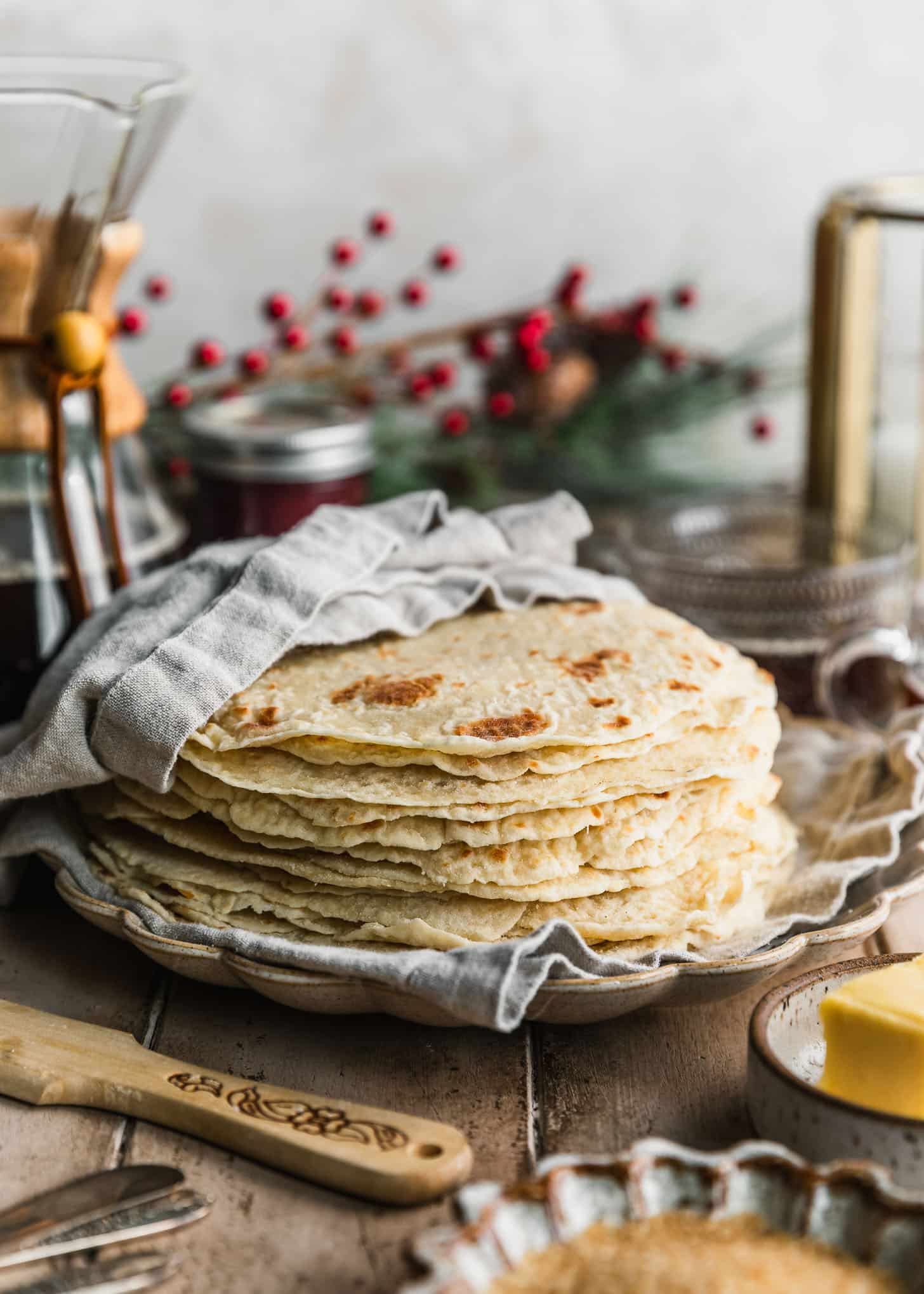
My family makes lefse every single Christmas, and it’s by far my favorite part of the year. So naturally, when I actually went to Norway, I was under the impression that it would be everywhere. Spoiler alert: I was wrong. I went to various bakeries, grocery stores, and restaurants but there wasn’t a lefse to be seen.
But, on the bright side, Norway is where I had my first cardamom bun, thin and buttery Norwegian pancakes, and perfectly-spiced gløgg. So I still left full, happy, and full of carbs. And now that Christmas is back around, I’m so excited to share this family recipe that I’ve been making ever since I was a kid!
Lefse is one of those things where everyone’s grandma has their own way of doing things. So maybe I’m biased, but this one is definitely my favorite. It’s slightly potato-y, pillowy, and totally perfect. Gather your friends, call your family, and let’s make it.
Use fresh potatoes
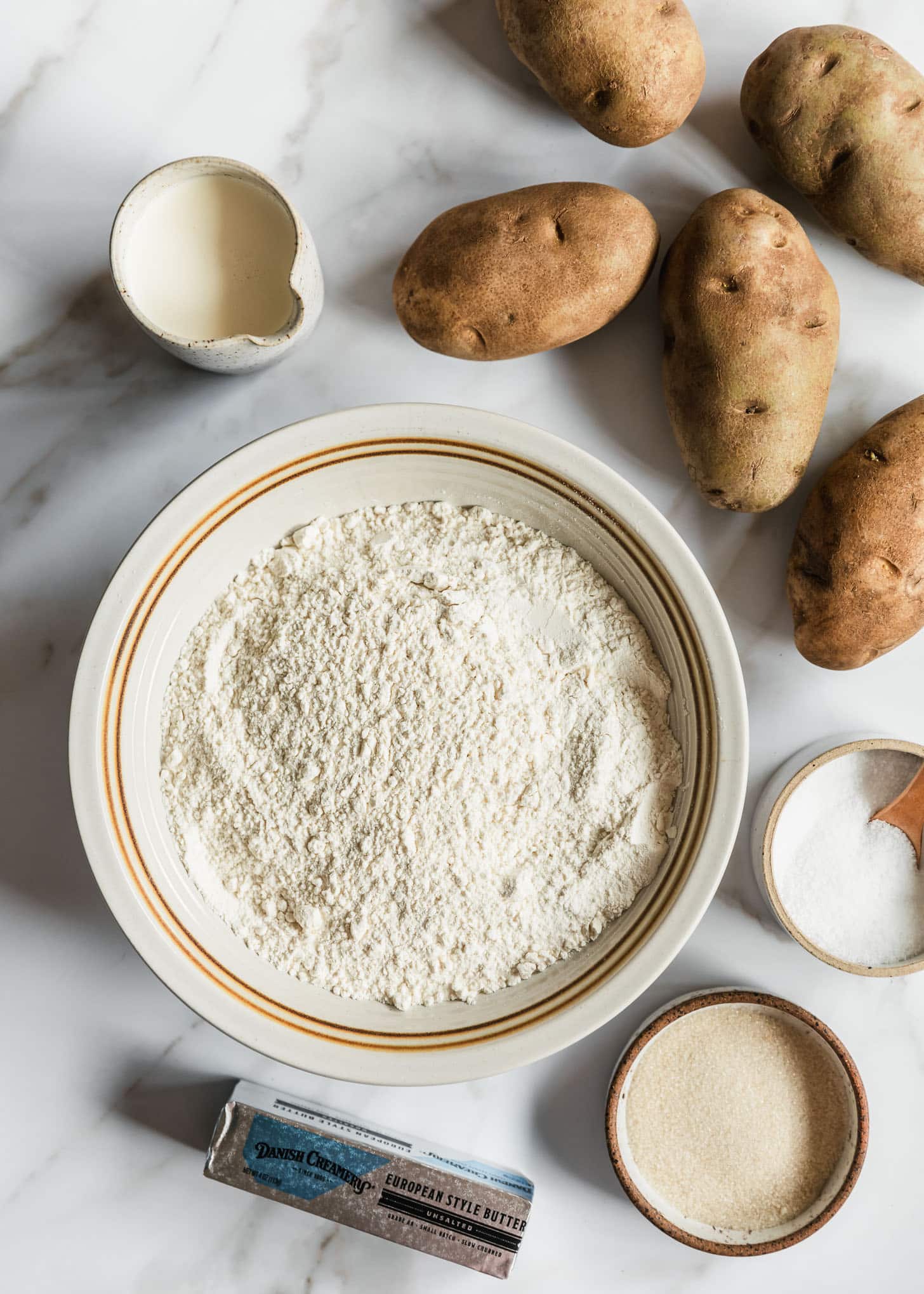
A lot of recipes used boxed mashed potatoes, but I think it makes lefse taste bitter. So, I usually go with Russet potatoes which gives us flatbread that’s nice and moist with a hint of potato flavor. Red potatoes are also commonly used in Norway!
You’ll also need some good-quality butter. I recommend unsalted European butter which has higher fat and makes for richer dough. Other than that, grab some all purpose flour, Morton’s Kosher salt, sugar, and heavy cream.
Prep the potatoes

Mix the dough
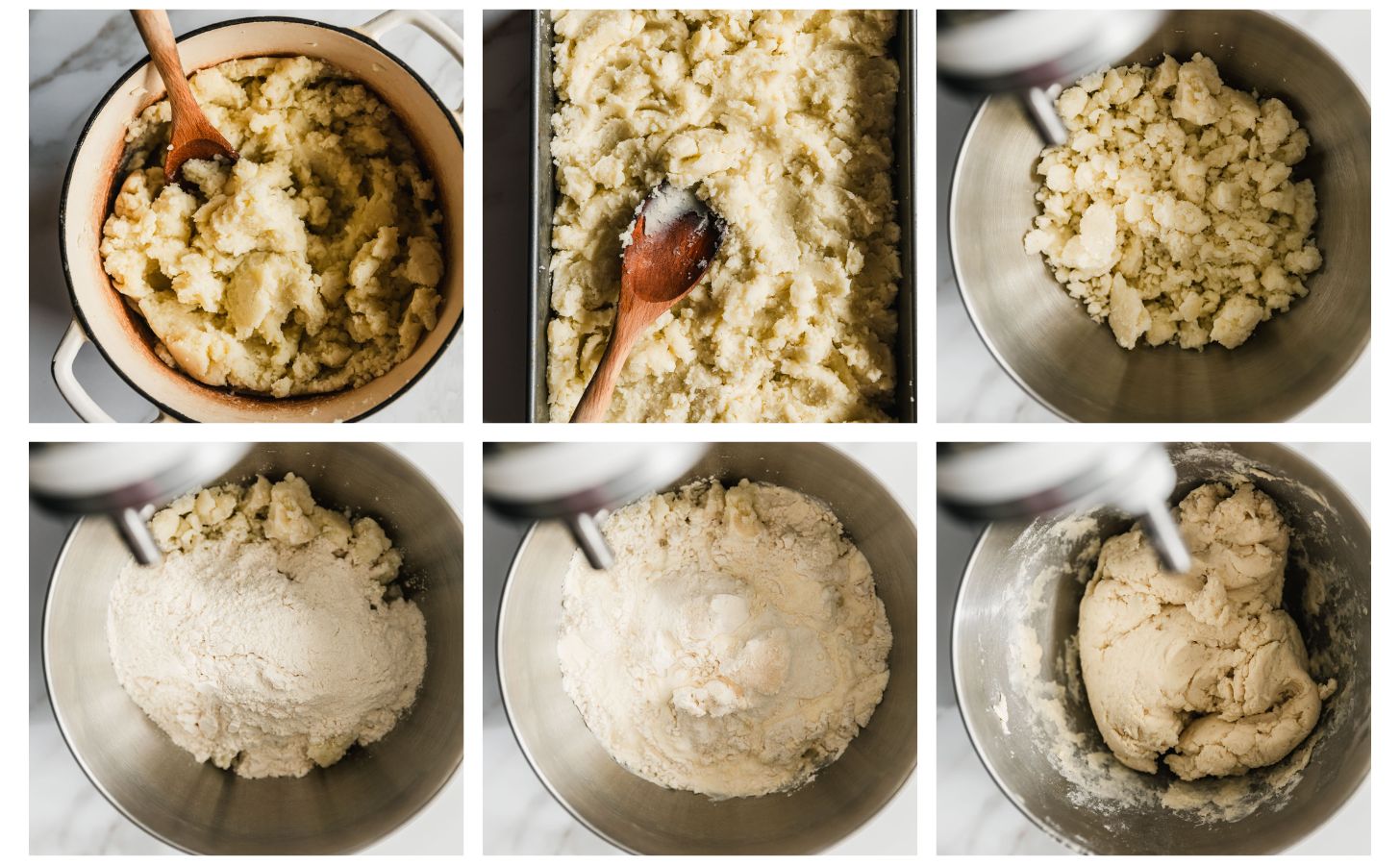
Form the dough
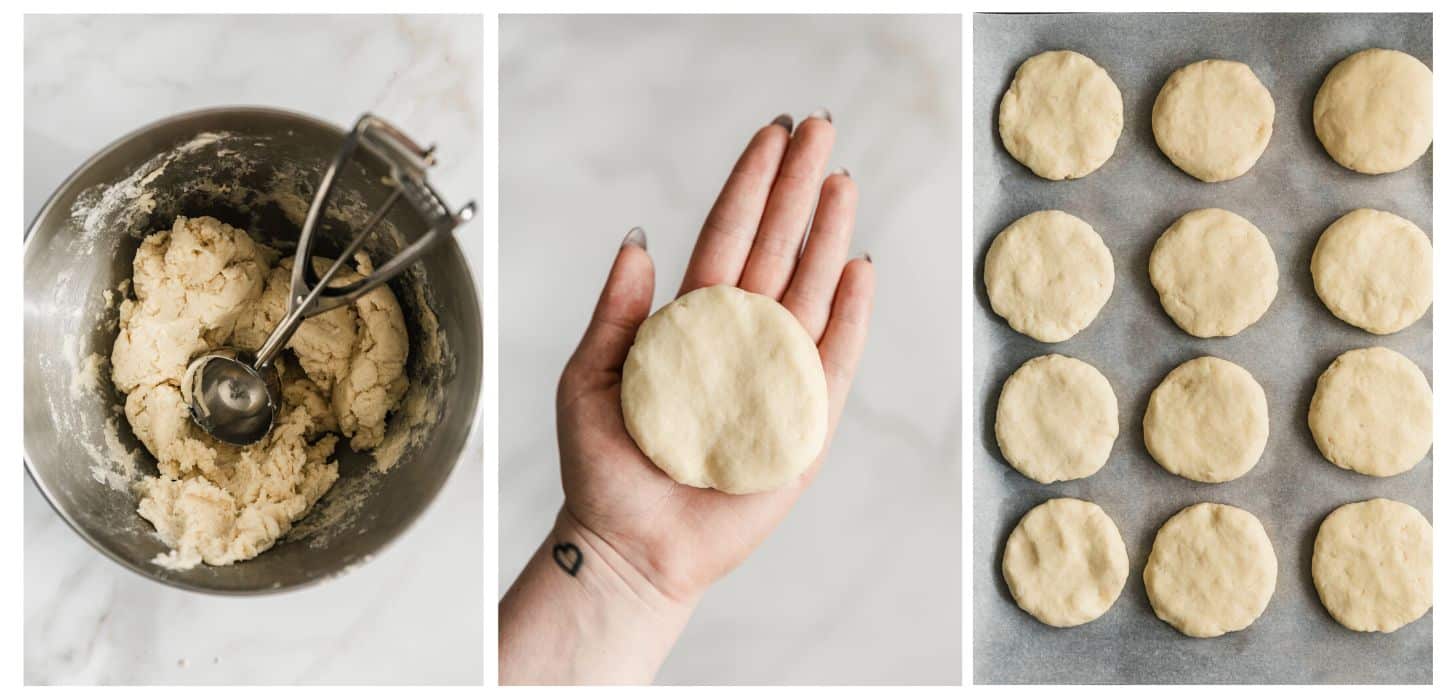
Roll & cook
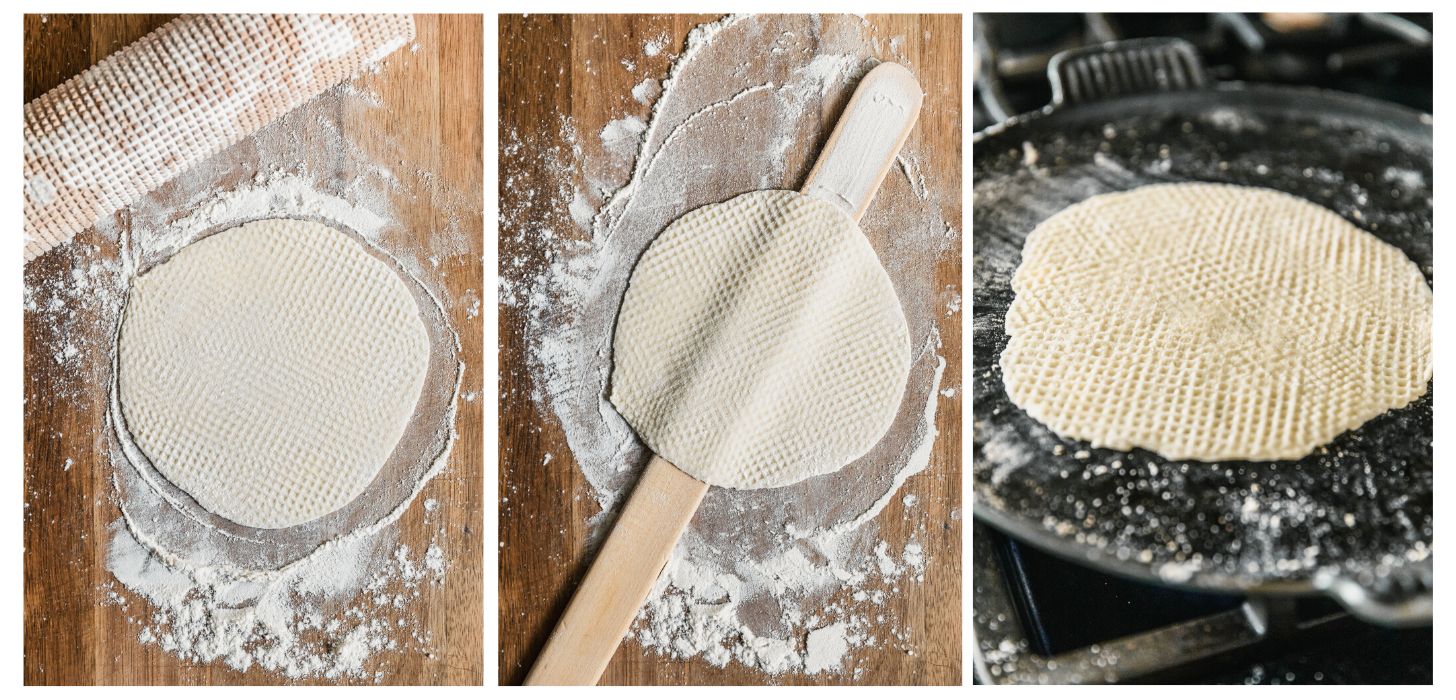
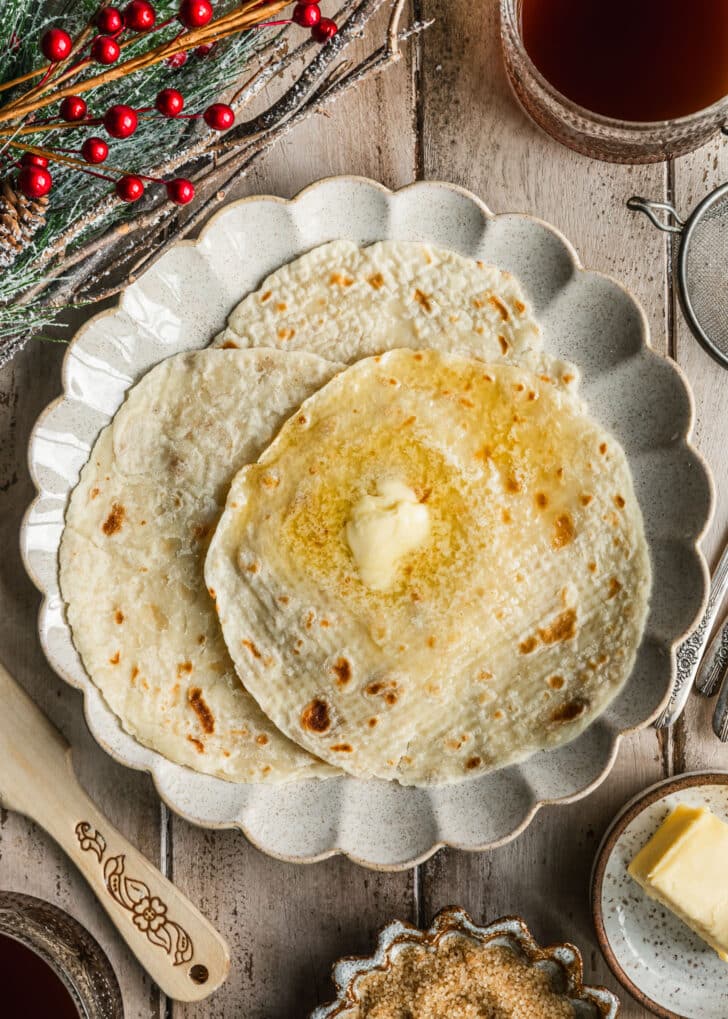
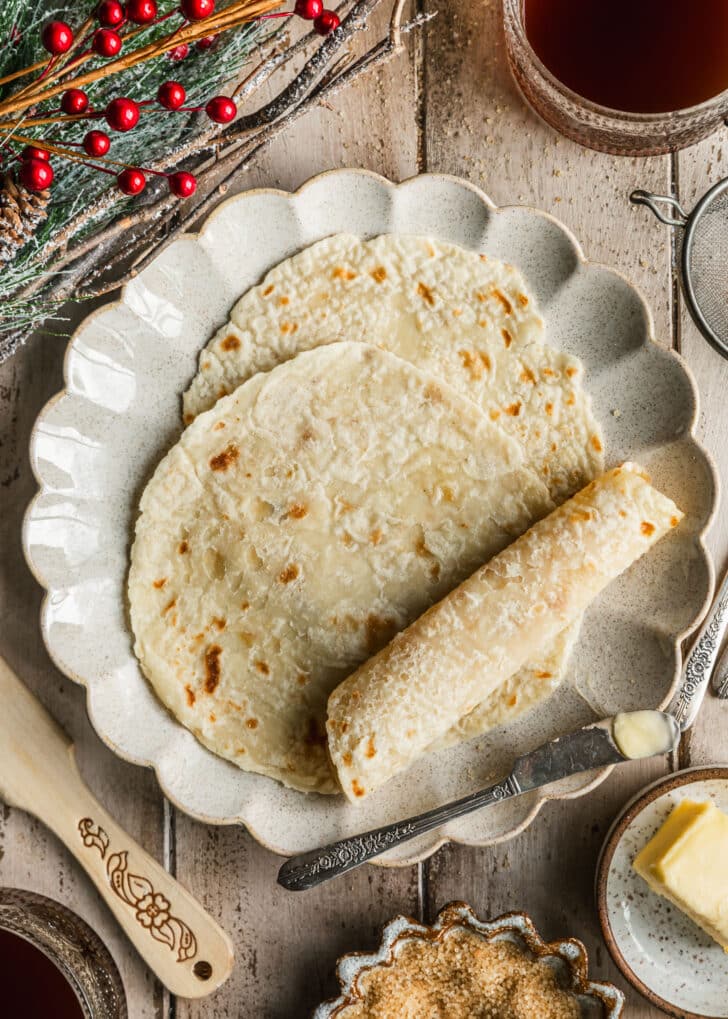
Rolling lefse
Rolling this dough can be a bit frustrating if you’ve never done it before. But after making lefse basically my whole life, I’ve found a few little tips and tricks to help make the process a bit easier.
- Dust the surface with lots of flour. You don’t want the dough to stick or it will be really hard to roll.
- Use dough right from the fridge. Cold dough is much easier to roll than warm dough.
- If your corrugated rolling pin is sticking, start by using a regular rolling pin to thin out the dough. Then, use the corrugated pin to add the square texture for the last 2-3 rolls.
- For round flatbread, roll the dough 1-2 times and then turn the dough a quarter. Repeat over and over until the dough is thin and round.
This dough is very delicate so be careful when you’re rolling it. Keep the rolling gentle so the dough doesn’t pull apart or stick to the rolling surface.
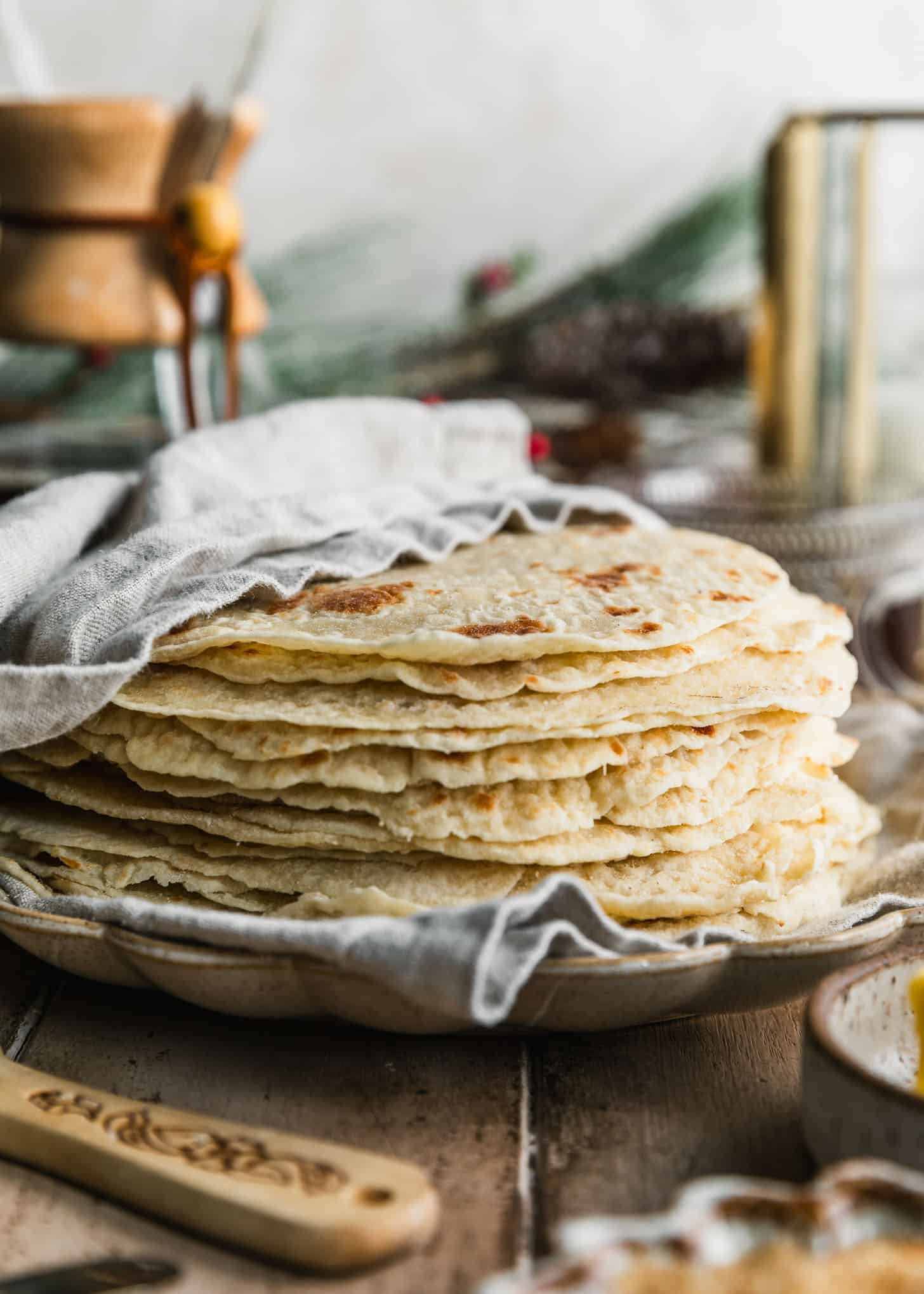
Filling ideas
There are so many ways to eat this flatbread whether you’re into sweet or savory! Here are a few of my favorite ways:
- Good quality butter + sugar – this is usually how we eat it!
- Topped with lingonberry jam.
- With a sprinkle of cinnamon and/or cardamom.
- As a side dish with soup.
- Rolled up with mayo, deli meat, and cheese.
- With meatballs and gravy.
Storing & make-ahead
Wrap the entire stack in a tea cloth. Place the stack in a zipper bag or airtight container and refrigerate for up to 5 days. After a few days, the flatbread will start to lose its moisture.
To freeze leftovers, stack the flatbread in-between layers of parchment paper. Place the stack in a zipper bag or airtight container and freeze for up to 3 months. Let it defrost in the fridge overnight before serving.
I like to wrap the lefse in a tea towel before storing it in a zipper bag or airtight container. The tea towel keeps the flatbread from drying out in the fridge!
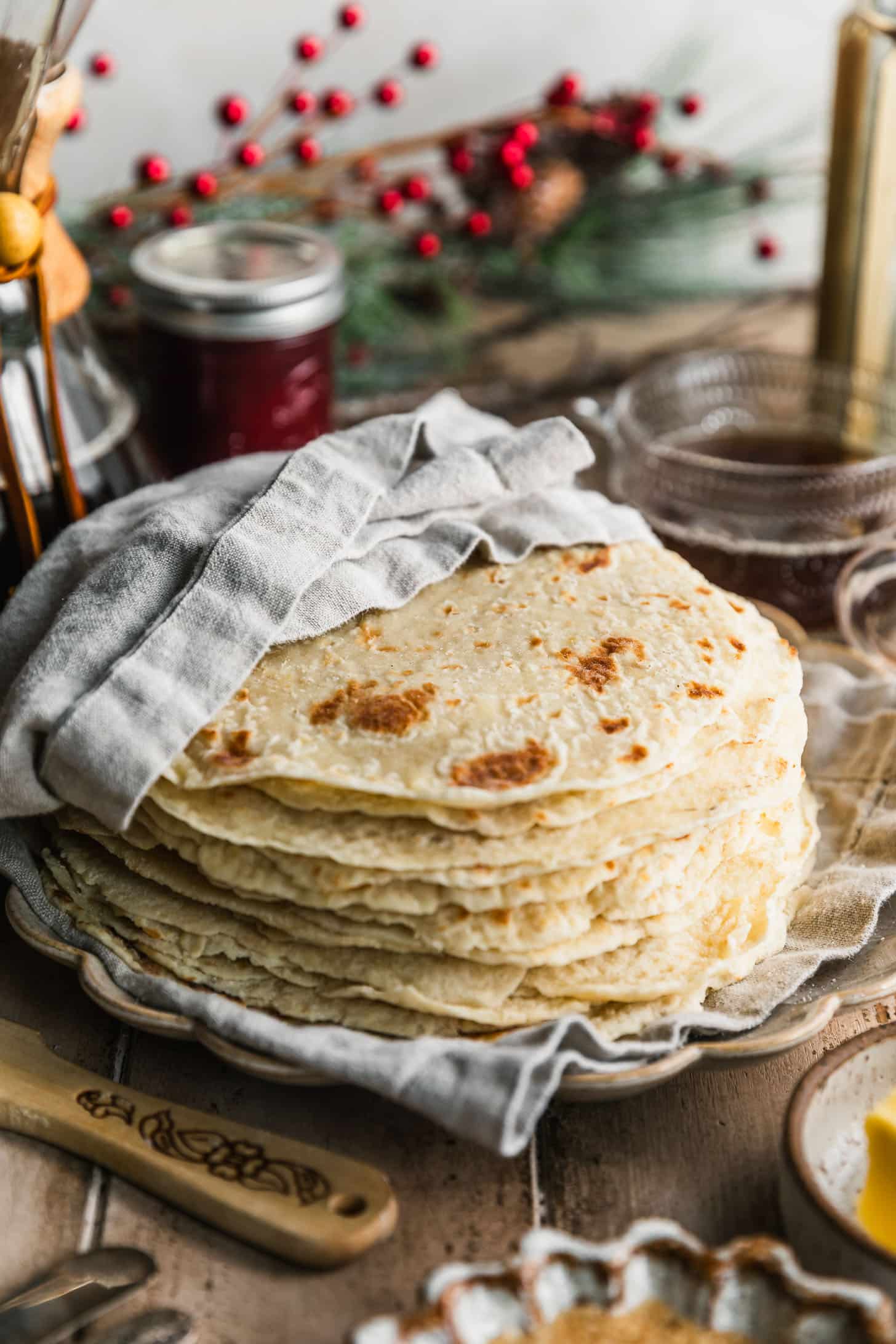
For the best results, I definitely recommend using a kitchen scale! It’s the best way to make sure the flatbread comes out perfect every time. If you don’t have a kitchen scale, make sure you’re measuring the flour properly. Whisk the flour until it’s fluffy and spoon the fluffed flour into a measuring cup. Then, level the flour without packing it in.
If you make this recipe, I would love it if you left a star rating and review! I read every single comment and love hearing what you think about my recipes. Thank you for supporting Sunday Table!
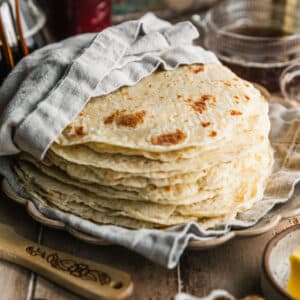
Norwegian Potato Lefse
Ingredients
- 1.85 kilograms russet potatoes (4 pounds)
- 113 grams unsalted butter, preferably European (1/2 cup)
- 450 grams all purpose flour, plus more for rolling (3 3/4 cups)
- 1 1/4 teaspoons Kosher salt, plus more as needed
- 32 grams sugar (2 1/2 Tablespoons)
- 300 milliliters heavy whipping cream (1 1/4 cups)
Instructions
- Start by peeling the potatoes and cutting them into quarters. Meanwhile, bring a large pot of salted water to a boil. Once the water comes to a boil, add the potatoes and boil them until they are fork tender, about 15-18 minutes.
- Rice the potatoes into a pot or large mixing bowl. You should have about 10 cups (1 kilogram) of riced potatoes. While the potatoes are still hot, add the butter and stir the mixture until the butter is melted and incorporated. Evenly spread the potatoes into a 9×13 pan and refrigerate the potatoes, uncovered, overnight.
- The next day, add the chilled potatoes, flour, salt, sugar, and heavy whipping cream to the bowl of a stand mixer. (Depending on the size of your mixer, you may have to do this in 2 batches.) Using a dough hook, mix everything together until a thick dough forms.
- Heat a griddle to 350°F (177°C). Then, using a cupcake scoop, form the dough into 3-4 Tablespoon balls. Using clean hands, flatten each ball into a smooth disc. Place the discs on a parchment-lined sheet pan, cover with a tea towel, and refrigerate.
- Dust a pastry board or wood board with a generous dusting of flour. Using a corrugated rolling pin, roll each dough disc, turning it a quarter after every 2-3 rolls, until you have a thin, round flatbread.
- Use a lefse stick to carefully transfer the lefse to the hot griddle. Cook the lefse for 1-2 minutes on each side until it's thoroughly cooked through and has small golden spots. Don't overcook the lefse or it will end up brittle. Let the lefse cool completely for a couple of minutes. Repeat with the remaining dough.
- Once the lefse is completely cooled, stack the lefse and wrap them in a tea towel to keep them from drying out. Place the stack of lefse in a zipper bag or airtight container and refrigerate for up to 5 days.
- Serve the lefse warm or at room temperature with butter, sugar, cinnamon, cardamom, jam, meatballs, deli meat, and anything else you like. Enjoy!
Notes
Originally posted in 2015.



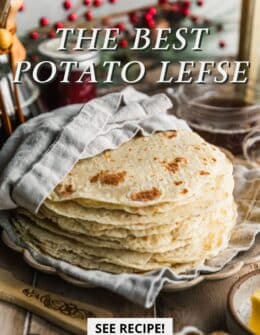
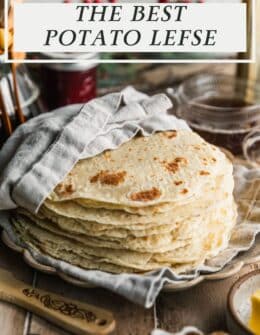
Hello! Are you related to Sara Lynn Naas?
Lisbeth:-)
Hi Lisbeth, I am not related to her, but I like her name 😉
Thank you for making something that looks nothing like a crepe and more like a tortilla. Like you, I grew up with these. My Dad was first generation Norwegian in the US. My Mom’s family decidedly English. My aunt taught my Mom to cook these.. maybe not so fancy as yours, though… yes, the potatoes might have been cooked the night before… deliberate “leftovers” from last night’s dinner. Rolling pin, hmmm… guess so, not no fancy scoop’s just the large mixing spoon, often pressed a bit between palms before being propped onto the floured board and rolled out. Fingertips pressed an edge against the rolling pin when they were just right, and the pin carried the lefse to the stove. There, a large iron skillet sat heating over a gas flame, waiting for it’s turn in the process. Never took long. Although the pan wasn’t on high heat, lefse isn’t thick and soon was flipped with the longest broadest spatula I the kitchen, mostly reserved for just that task, and served….
One at a time, warm, ready for butter, and whatever tasty morsels were added. As you said, breakfast might include an egg and bacon or sausage .. lunch could have been meat and/or cheese…
Sometimes it was cottage cheese…UES with Cardamon seeds !!!
Dessert were the sweet treats. Butter and sugar, or cinnamon sugar, maybe leftover frosting from a cake.
Yes – always available, for any meal, but Mom’s almost never made it to the fridge for later.
P. s. A side note… how about Krumkake ?
Aww these sound like so many amazing memories! I’m definitely going to try it for breakfast with eggs and bacon. 🙂 I have not posted a recipe for krumkake yet, but I definitely want to next holiday season! xx.
Your recipe & explanation of the important steps of mastering the technique of making Lefse are spot on. You only need to add more importance to the Lefse stick & it’s positive application in transferring the thin rolled bread from flowered surface to griddle. How to roll it on to & off of the stick is an art then to use the stick to flip the nicely browned bread one time and on to your stack of Lefse
Thank you, Robert! The lefse stick is definitely so important, thank you for sharing!
I can’t wait to try your tips – I’ve learned with the instant mashed recipe and am about to try tackling with the real potatoes. As my grandma said to me “being Norwegian is a LOT of work!!” I didn’t think it was as hard as she said – and I think your tips will be really helpful to take some of the extra work out of the lefse as I learn to perfect this treat!! I’m not sure why it is just for holidays. We recently tried all kinds of fun things on the lefse – including peanut butter and bananas – a little chocolate and peppermint dust – and apricot jelly was my favorite!!
Thank you so much, Andrea! It’s definitely worth it to make the lefse with fresh potatoes. 🙂 Also, I agree – I think lefse should be a year round thing. I’m definitely going to try it with apricot jelly, so delicious!
My grandma taught my mom who then taught me. But it’s been years. I love your recipe. ( for some reason, my grandma used some of the potato water in hers. I prefer yours! I Rand the potatoes through the ricer once. 2nd time with the butter, then hand mixed in the salt, flour and cream and then ran it through the ricer a third and final time. Not a single lump or bump. Rolled out beautifully and made, what I think, was perfect lefse! Thank you for your recipe!
Amazing, I’m so glad you loved the recipe, Lynda! My mom and I also made this last week and it’s my favorite holiday tradition. 🙂 Thanks for trying this version!
I plan to try to make this this weekend. I have NEVER made lefsa, but LOVE it. I just inherited my Norwegian Grandma’s lefsa rolling pin, griddle and stick. And promised her I would try to bring some at Thanksgiving. (So wish me luck). I will rate 5 stars for now as this look like the perfect recipe. And will come back if I run into issues!
I also saw some comments regarding a Krumkake recipe that we used while growing up that came on a box with a Krumkake iron back in the 1950s?? I’ve tried several others, but that one is still the best. feel free to reach out if you want me to share it! I have both of these on my list to make this weekend along with some Søtsuppe: Which according to my cousins in Norway, their grandparents used to make, but seems to have been lost somewhat in the generations. As for us, it is still a favorite we’ve carried down over the years since immigrating to the U.S.
Thank you so much, Kristin! This recipe is by far my favorite, I hope you and your grandma love it. 🙂 It’s definitely some work, but so worth it. And yes, I would love a Krumkake recipe, my mom and I are going to make it together this year with my grandma’s pan, thank you for offering! I’ll have to try Søtsuppe this year too, I haven’t personally had it, but I’ve heard my grandpa talking about it before!
My riced potatoes are in the refrigerator chilling.. as for the Krumkake recipe. After digging out the box and looking at it, the one we normally use is the Nordic Ware Lemon Krumkae recipe.. I did a search for it on line and it hasn’t changed since this box was printed 50+ yrs ago.
They do also have one on there for Cardamom Krumkakes, which I haven’t tried. I’ll be excited to see if you come up with a different one.
Good Luck!
First of all, I have never been hugely successful in making lefse that had the proper texture and tenderness until I tried this recipe. My few attempts at summoning my Norwegian roots have only resulted in something close to shoe leather. This recipe so reminded me of my Grandmother’s (both sides of the family) lefse, like all the way back to when I was a little girl lefse! But instead of the traditional butter, cinnamon and sugar or brown sugar, we tried Texas Roadhouse cinnamon butter and I must say, what a heavenly combination!!
I am so happy to hear that, Andrea! Good lefse is hard to find, but once you know how to make it, it’s so worth it. I’m thrilled to hear that this one reminds you of your grandma’s just like it does mine. 🙂 Definitely trying with the Roadhouse cinnamon butter, that sounds amazing!
This is the perfect recipe, thank you for posting it. Mine turned out exactly like the lefse we ate growing up 🙂 my kids have been obsessed with eating it with Nutella! Made a double batch to share with everyone <3
Aww thank you, I love to hear that, Emily! I bet it’s sooo good with Nutella!